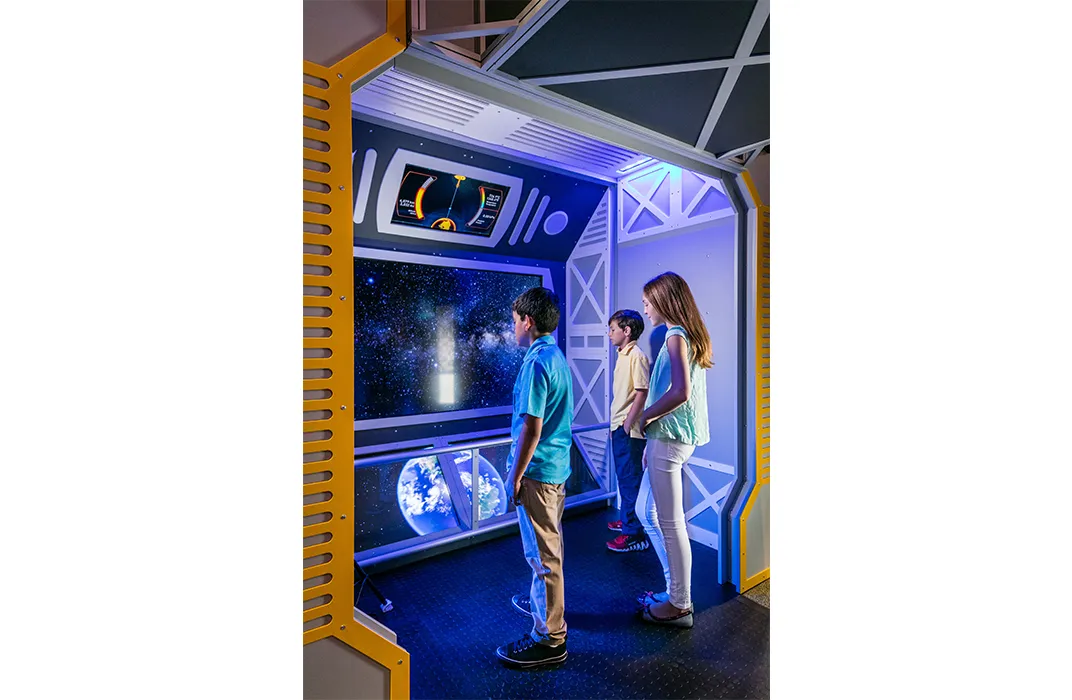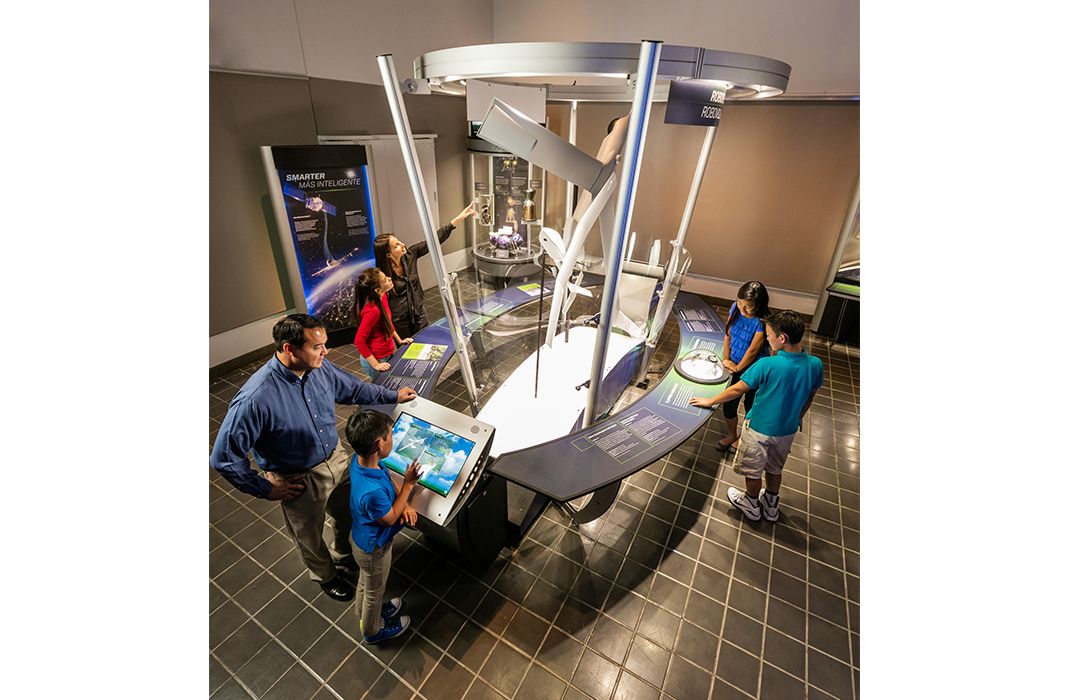A Next Gen Museum Show Takes Aim at Inspiring Next Gen Ingenuity
Curators are betting high-tech playtime will turn today’s kids into tomorrow’s engineering visionaries
:focal(296x367:297x368)/https://tf-cmsv2-smithsonianmag-media.s3.amazonaws.com/filer/4b/a6/4ba67337-4d7d-45d1-afee-3743bbcc4313/fullthrottleweb.jpg)
A flashy new exhibition at the National Air and Space Museum not only replicates an elevator to space or a flight to Mars, it may also show how future museum shows may look.
“We’ve never had as tech heavy an exhibition here as this one is,” says curator Roger Launius of what he calls the “strikingly different” new “Above and Beyond: The Ultimate Interactive Flight Exhibition” that just opened a five-month run in Washington, D.C. “Obviously we do interactives, and some of them are electronic and some of them are mechanical,” Launius says of the other galleries and displays in the popular Air and Space Museum on the National Mall. “But this is the one that has the most electronics we’ve ever had. In fact almost everything in the exhibition has a touch screen, or a video screen or something to do.”
The 5,000-square-foot show, designed by San Antonio-based Evergreen Exhibitions and funded in part by Boeing, has no less than 16 interactive stations designed especially to draw the tech-oriented digital natives of the 21st century.
“The group that we’re really talking about were born since 2000, and most of them, from the first time that they could do anything, had an iPad or smartphone in their hands,” Launius says. “They are fully integrated into the electronic age in the ways that I’m not. They really would like to engage in that particular way. So this is a way to try to help them do that.” The idea of the show is to celebrate and inspire innovation, Launius says—and maybe inspire the next generation of air and space visionaries.
Visitors can be transformed into virtual birds, experience a simulated wind tunnel and design drones. Throughout the history of flight and space travel, the emphasis has been on flying higher, faster or farther. In more recent years, there has been another goal in the aerospace industry, Launius says: Smarter.
“Can we build things more efficiently? Can we build them so they are more economical? Can we build them so they are more safe?” he says. “And all of that is part of this particular story.”
Vehicle concept models and prototypes, interactive challenges and immersive technology are all there to lure kids who’ve been so closely tied to their own personal technology and electronics.
The Air and Space Museum may have some of the most amazing flying machines assembled in one place, from the early planes of the Wright brothers to Lindbergh's Spirit of St. Louis to the Mercury spacecraft and the Apollo command module—but that still might not be enough to engage kids.
“People who are a little bit older are awed by these icons like the Wright Flyer and the Spirit of St. Louis,” says Launius. “But a 10 year old? Probably not in the same way. So how do we hook them?”
Touch tables, virtual reality, flight simulation and skill challenges are the answer in “Above and Beyond.” Of course adults are also welcome to the exhibition that will be staged in nine different cities through 2016, including St. Louis, Seattle, Chicago and Charleston, S.C. as well as such international spots as London, Tokyo, Dubai and Riyadh, Saudi Arabia.
But for grownups for whom computers are not second nature, “it does take a little more work,” Launius says, though he adds, “it’s not hard to figure out. “It’s not intuitive to me that I need to do a certain thing when I see a screen necessarily.”
And the payoff leads to something like Launius’ favorite stop in the show, the elevator to space.

“I love the concept,” he says. “Whether or not we’ll see a space elevator is an open question. But there are people who are actively engaged in research to make something like that happen.”
The elevator concept eschews rockets and begins instead with “basically a very thin, very resilient strand of material from the ground to geosynchronous orbit, which is about 22,000 miles up.”
There are challenges in accomplishing that, he says, but once it's possible “you can attach what amounts to an elevator to it, and the elevator just runs up and down this thing. And you’re inside this little cargo compartment.”
An elevator instead of a ship, he says, “would change the dynamic of how to get to space. And we have visualized this in the exhibition.”
Stepping into the demo, “ you go past where the international space station is, and past where the GPS satellites are, and you go on up to the top where most all the communications satellites are located and then come back down.”
An actual trip in a future elevator would take hours, but the demonstration is over in 3.5 minutes. “It’s really cool," Launius says.
While some parts of the show, such as a timeline or a screen where visitors can simulate the movements of birds, most of “Above and Beyond” is about the future.

“That was by design,” Launius says, to engage kids. “The 21st century is going to be a lot more exciting than the 20th century when it comes to these things,” he says. “So what are those possibilities? Can we get them excited about that? That’s sort of the approach that we’re taking.”
The heavily interactive format is also a peek into what more and more museums will be doing to present their material in a more dynamic fashion.
“Probably not all of our exhibits are going to be this tech heavy in the future,” Launius says. “But there will be more of these kind of interactive experiences.”
Seeing how visitors react to them will also be helpful, he says. “And as a museum that approaches 8 million people a year, we’re also interested in the hardiness of these things, and whether or not they’ll keep running. That’s been one of our challenges in the past. How many fingers have to touch the screen before it no longer works? So we’d like to learn more about this through this process.”
For now, Launius says he wants to inspire the kids that do clamor for the exhibition.
“This is a term I hear from everybody who works in the aerospace community: Inspire the next generation,” he says. “I’d love to do that too. I think that’s a worthy goal. Teach them about the past, explain to them about the prospects of the future, and how truly exciting it can be. And that they can be a part of it. “
“Above and Beyond: The Ultimate Interactive Flight Exhibition” continues through Jan. 3, 2016, at the Smithsonian’s National Air and Space Museum, Sixth Street and Indpendence Avenue SW, Washington, DC.
/https://tf-cmsv2-smithsonianmag-media.s3.amazonaws.com/accounts/headshot/RogerCatlin_thumbnail.png)
/https://tf-cmsv2-smithsonianmag-media.s3.amazonaws.com/accounts/headshot/RogerCatlin_thumbnail.png)